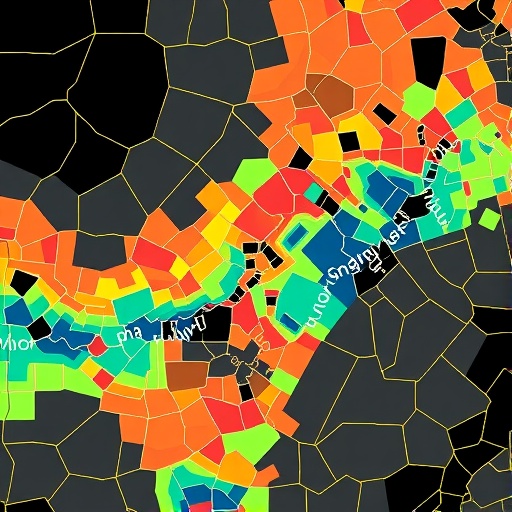Researchers are increasingly turning to the vast potential of machine learning to unravel the complexities of genetic variation and population dynamics. A groundbreaking study titled “Machine learning-based discovery of informative SNPs for population assignment through whole genome sequencing” affects this growing field profoundly. The authors, Liang, H., He, Y., and Si, J., and their research team have made headway in identifying single nucleotide polymorphisms (SNPs) that serve as critical markers for population assignment using advanced computational methods. The implications of their findings are set to reshape our understanding of population genetics in the near future.
SNPs are the most common type of genetic variation among people. These small alterations in the DNA sequence can influence various traits, susceptibility to diseases, and even responses to medications. We often think of them as minor, but their cumulative effect is essential in understanding human diversity and evolution. This study highlights the potential of machine learning algorithms, which can analyze extensive datasets far beyond human capacity, to sift through genomic information effectively and extract meaningful genetic clues.
The approach taken by Liang and colleagues leverages whole genome sequencing, a powerful technique that allows for the comprehensive analysis of an organism’s entire genetic makeup. This innovative method means that researchers can uncover hidden genetic patterns that traditional techniques may overlook. Coupled with machine learning, it also enables the identification of informative SNPs that are relevant for population assignments, which could revolutionize genetic studies and clinical applications alike.
Machine learning excels in recognizing patterns and making predictions based on large datasets, which is invaluable in genomics. By applying these techniques to genomic data, Liang et al. discovered that specific SNPs could reliably indicate population membership. Their use of advanced algorithms not only enhances the accuracy of population assignment but also reduces the time and resources needed to analyze genomic data. This efficiency is pivotal, especially as the volume of genomic data continues to grow exponentially.
Understanding population structure through SNPs can have significant implications in various fields, including medicine, anthropology, and conservation biology. For instance, in personalized medicine, determining a patient’s genetic background can lead to more tailored treatment plans. Similarly, in conservation efforts, identifying genetic variations within species can aid in preserving biodiversity and managing endangered populations.
The study meticulously details the methodology employed in their research. It outlines the specific machine learning algorithms utilized, the dataset characteristics, and the resulting SNPs identified as informative for population assignments. The transparency in their approach sets a precedent for future studies, encouraging replication and validation by other researchers. Moreover, by making their dataset publicly available, the authors invite collaboration and further exploration of their findings.
As the conversation around population genetics continues to evolve, the work of Liang and colleagues prompts essential questions about the ethical implications of using genetic data. While the benefits of such research are clear, concerns about privacy, data security, and the potential misuse of genetic information remain pertinent. How society navigates these ethical dilemmas will shape the future landscape of genetic research and its applications.
Importantly, the study addresses the robustness of their findings, demonstrating the reliability of their SNP markers across diverse populations. This validation process is crucial, as it ensures that the markers identified can be generalized beyond the specific populations initially analyzed. Researchers now have a set of tools that can potentially be applied to a broader spectrum of genetic studies, paving the way for enhanced understanding of human genetics.
In a rapidly evolving field such as genomics, the collaboration between data science and biology is of utmost importance. This study serves as an exemplary model for interdisciplinary research, marrying advanced computational techniques with biological inquiries. By integrating these two fields, researchers can unlock new insights that were previously unattainable, thereby pushing the boundaries of what we know about genetic diversity.
The implications of discovering informative SNPs are vast and varied. For instance, aside from clinical applications, these findings could enhance our comprehension of evolutionary biology. By analyzing population structures and migrations through SNP data, scientists can trace back lineage and understand how human populations have evolved over time. Such insights can not only aid in the reconstruction of human history but also contribute to identifying genes associated with specific traits or diseases that have surfaced in particular populations.
As with any scientific inquiry, this groundbreaking research opens doors for future studies. The authors suggest potential avenues for exploration, including the application of their findings to study historical populations and the adaptation of specific traits. Additionally, they highlight the significance of refining machine learning models to increase accuracy and predictive power in population assignments. The ongoing evolution of these methodologies promises to further enhance our understanding of genetics on a population level.
In conclusion, Liang, H., He, Y., and Si, J.’s research presents a significant advancement in the field of population genetics through the innovative application of machine learning techniques. Their work paves the way for deeper insights into human genetic diversity and its implications across various spheres of research. As genomic data becomes more accessible, the potential for transformative change in our understanding of genetics expands, inviting researchers to delve deeper into the secrets of population assignments and genetic variation.
Subject of Research: Population Genetics, Machine Learning in Genomics
Article Title: Machine learning-based discovery of informative SNPs for population assignment through whole genome sequencing
Article References:
Liang, H., He, Y., Si, J. et al. Machine learning-based discovery of informative SNPs for population assignment through whole genome sequencing.
BMC Genomics (2025). https://doi.org/10.1186/s12864-025-12322-1
Image Credits: AI Generated
DOI:
Keywords: Machine Learning, SNPs, Population Assignment, Whole Genome Sequencing, Population Genetics, Genomic Data, Personalized Medicine, Ethical Implications, Genetic Variation, Interdisciplinary Research.
Tags: advancements in population dynamics studycomputational methods in genomicsgenetic variation analysis techniquesgenomic data analysis innovationshuman genetic diversity researchimplications of SNP discoverymachine learning algorithms in biologymachine learning in geneticspopulation assignment through geneticssingle nucleotide polymorphisms (SNPs) for population geneticsunderstanding evolution through geneticswhole-genome sequencing applications





